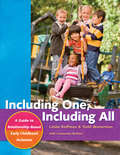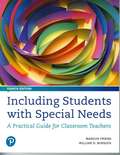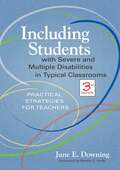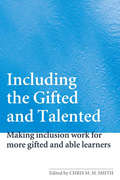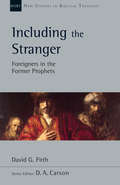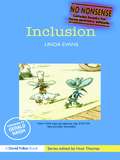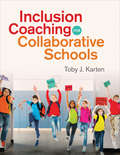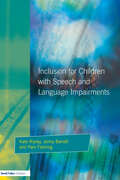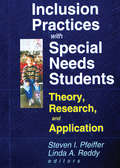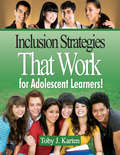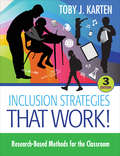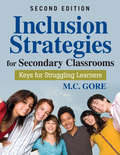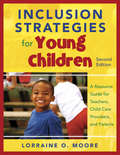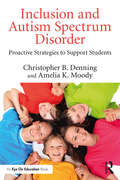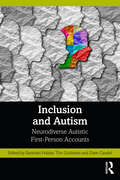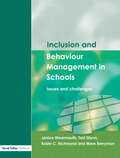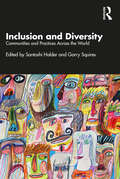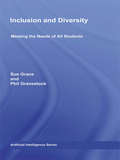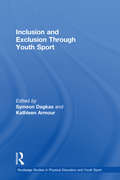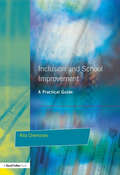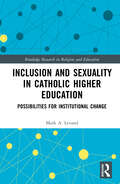- Table View
- List View
Including One, Including All
by Cassandra Britton Todd Wanerman Leslie RoffmanInclusive early childhood settings benefit all children, whether or not they have identified special needs. Including One, Including All provides theoretical, conceptual, and practical information on relationship-based, inclusive practices for early childhood classrooms, an approach that strengthens every child and supports the child's behavioral, emotional, social, and learning challenges. Written by a team of professionals who are known for their successful work using this model, Including One, Including All includes blueprints for organizing this important work with children and their families and addresses the challenges and rewards of inclusion in early childhood classrooms, and chronicles the experiences of two children with special needs in early childhood settings.
Including Students With Special Needs: A Practical Guide For Classroom Teachers
by Marilyn Friend William D. BursuckIncluding Students with Special Needs provides readers with a firm grounding in critical special education concepts, an understanding of the professionals who support students with special needs, knowledge of the procedures that should be followed to ensure that students with special needs rights are upheld, and a wealth of research-based strategies and interventions that we know help foster student success. Filled with realistic school scenarios, additional vignettes of children with disabilities and other special needs, new information on multi-tiered systems of support, and over 400 new reference citations, the 8th Edition introduces pre-service teachers to the complexities, realities, and rewards of being a professional educator today.
Including Students with Severe and Multiple Disabilities in Typical Classrooms: Practical Strategies for Teachers
by June E. Downing Martha E. SnellThe bestselling resource from the most trusted name in special education gets a top-to-bottom update in this new third edition. Revised to reflect the realities of today's K-12 classrooms, this book gives teachers all the latest research-based, practical strategies for fully including students with sensory impairments and cognitive and physical disabilities.
Including Students with Special Needs
by Marilyn Friend William D. BursuckThis single most-adopted Inclusion text worldwide continues to provide the best source of practical strategies for teaching students with special needs in inclusive settings. Filled with examples and vignettes, the emphasis is always on teaching methods that promote student independence at all education levels.
Including the Gifted and Talented: Making Inclusion Work for More Gifted and Able Learners
by Chris M. M. SmithThis single volume presents the views of experts from the field which challenge the assumption that educational inclusion relates only to those pupils with learning difficulties. In this book, the authors examine the extent to which a truly inclusive context can provide a challenging environment for gifted and talented pupils. Key issues explored include: the social and emotional aspects of being a gifted and talented pupil the pros and cons of being labelled gifted and talented in very young children why ‘regular’ classrooms are the best place to educate gifted and talented pupils modifying the basic school curriculum to meet the needs of gifted and talented pupils What is submerged talent and how can it be found? As the Government has recently initiated the Excellence in Cities scheme, this thought-provoking volume is an invaluable read to student teachers, practitioners, academics and researchers who wish to further their study in this hot topic.
Including the Stranger: Foreigners in the Former Prophets (New Studies in Biblical Theology #Volume 50)
by David G. FirthThe Old Testament, particularly the Former Prophets (Joshua, Judges, 1-2 Samuel, and 1-2 Kings), has frequently been regarded as having a negative attitude towards foreigners. This has meant that these texts are often employed by those opposed to the Christian faith to attack the Bible—and such views can be echoed by Christians. While the story of David and Goliath is cherished, other episodes are seen to involve "ethnic cleansing" or "massacre" and are avoided. David Firth's contention is that this approach emerges from an established interpretation of the text, but not the text itself. In this New Studies in Biblical Theology volume, he argues that the Former Prophets subvert the exclusivist approach in order to show that the people of God are not defined by ethnicity but rather by their willingness to commit themselves to the purposes of Yahweh. God's purposes are always wider than Israel alone, and Israel must therefore understand themselves as a people who welcome and include the foreigner. Firth addresses contemporary concerns about the ongoing significance of the Old Testament for Christians, and shows how opponents of Christianity have misunderstood the Bible. His reading of the Former Prophets also has significant ethical implications for Christians today as they wrestle with the issues of migration and what it means to be the people of God. Addressing key issues in biblical theology, the works comprising New Studies in Biblical Theology are creative attempts to help Christians better understand their Bibles. The NSBT series is edited by D. A. Carson, aiming to simultaneously instruct and to edify, to interact with current scholarship and to point the way ahead.
Inclusion (No-Nonsense Series)
by Linda EvansInclusion is much more than special needs – it’s also about helping the hard to reach, the gifted and talented, those with English as an additional language and much more depending on your area and its social and cultural diversity. Whatever the individual make up of your school, this book will tell you the basic principles that you need in order to both satisfy OfSTED and provide the right opportunities for your pupils.
Inclusion Coaching for Collaborative Schools
by Toby J. KartenBe the coach who leads your team to inclusion success! You’re already the go-to expert for help with inclusion practices. Now you can take your advocacy to the next level. As an inclusion coach, you’ll guide your school team in implementing the very best inclusion strategies for achieving quantifiable results. With planning sheets, curriculum examples, and other practical tools, Karten’s hands-on guide will help you: Establish your own coaching baselines Introduce research-based strategies for lesson planning, instruction, and recording data Engage staff in reflective and collaborative inclusion practices Manage challenges, including scheduling and co-teaching responsibilities
Inclusion For Children with Speech and Language Impairments: Accessing the Curriculum and Promoting Personal and Social Development (Resource Materials For Teachers Ser.)
by Jenny Barrett Kate Ripley Pam FlemingThis book is about children with speech and language impairments and what teachers and other professionals can do to promote their learning and their social inclusion in a mainstream setting. A brief introduction to SLI is followed by a chapter on the main issues for the classroom; how teachers can support the preferred learning style of the children and literacy and numeracy strategies are each given a separate section. Inclusion involves more than the learning experience and so the social, emotional and behavioral agenda, including successful transition and working with parents, is given equal emphasis.
Inclusion Practices with Special Needs Students: Education, Training, and Application
by Steven I Pfeiffer Linda A ReddyExplore the challenges, opportunities, and pitfalls of the inclusion of students with disabilities in your classroom!Exciting, complex, and challenging shifts in American education are occurring today. First, schools are moving to embrace student diversity and accommodate the classroom experience to support diverse ways of organizing students for learning. Second, teachers are moving away from a traditional didactic instructional mode and embracing a facilitator role that encourages creating innovative classroom learning opportunities. Third, there is a shift from the view of the school as providing educational and psychoeducational services for students to providing educational supports for learning.Coinciding with these changes is the growing movement in special education that enourages full inclusion of students with special needs. This is a far cry from the exclusionary and separatist movements of special education less than twenty years ago. Now American education is facing the challenging situation of working with students with disabilities in the regular classroom. Inclusion Practices with Special Needs Students provides a much needed overview of the issues faced by educators committed to understanding how to best serve children with disabilities in schools.Inclusion Practices with Special Needs Students: Theory, Research, and Application provides an overview of the origins, evolution, and recent developments regarding the inclusion of students with disabilities into general education classrooms. The book critically challenges the overriding assumptions that support the philosophy of inclusion with a balanced presentation or research and theory that both supports and raises questions about the viability of this practice. The contributors are authorities in their respective areas of inclusionary practices.Some of the issues you will explore in Inclusion Practices with Special Needs Students are: political, fiscal, and legal events that have shaped inclusion practices implications for school psychologists handling students with serious emotional, behavioral, or developmental problems remaining in regular education agenda for future research priorities for research, training, and policy reformInclusion Practices with Special Needs Students addresses practical, psychoeducational, philosophical, legal, ethical, and financial issues surrounding the inclusionary initiative in special education.
Inclusion Strategies That Work for Adolescent Learners!
by Toby J. KartenBacked by the author’s three decades of experience, this reader-friendly guidebook provides teachers with a practical approach for creating a successful inclusive secondary classroom. Toby J. Karten helps teachers use a variety of strategies, including differentiated instruction, universal design for learning, brain-based learning, RTI, and evidence-based practice. With helpful forms, activities, graphic organizers, and quotations throughout, this resource: <p><p> Outlines the theoretical background for creating an inclusive classroom environment <p> Describes the psychosocial, cognitive, physical, and moral development of adolescents and how they affect teaching practice <p> Provides research-based practices to maximize and honor learners’ potentials and strengths
Inclusion Strategies That Work!: Research-Based Methods for the Classroom
by Toby J. KartenThe go-to book for including ALL learners in educational success! Teaching students with diverse needs require educators to employ empathy, responsiveness, and patience. This book has long been the indispensable resource for K-12 teachers as they confidently form lesson plans and strategies for inclusion. In this new edition, Toby J. Karten’s data-driven methods are updated with the latest research and policy developments. The book’s content includes: Updated information on ADA, IDEA, writing IEPs, transitional services, classifications, RTI, metacognitive strategies, and links to the Common Core Tips for working with families and making them an integral part of the inclusive team An overview of special education legislative terminology Interactive online forms for planning, documentation, and collaboration
Inclusion Strategies That Work!: Research-Based Methods for the Classroom
by Toby J. KartenThe go-to book for including ALL learners in educational success! Teaching students with diverse needs require educators to employ empathy, responsiveness, and patience. This book has long been the indispensable resource for K-12 teachers as they confidently form lesson plans and strategies for inclusion. In this new edition, Toby J. Karten’s data-driven methods are updated with the latest research and policy developments. The book’s content includes: Updated information on ADA, IDEA, writing IEPs, transitional services, classifications, RTI, metacognitive strategies, and links to the Common Core Tips for working with families and making them an integral part of the inclusive team An overview of special education legislative terminology Interactive online forms for planning, documentation, and collaboration
Inclusion Strategies for Secondary Classrooms: Keys for Struggling Learners
by M. C. Gore"This updated text provides a wide range of instructional tools that are cleverly introduced, well-referenced, and clearly presented. The book gives preservice teachers an informative and practical introduction as they prepare to work with older students. As an excellent refresher for practicing teachers, it offers new approaches that can be incorporated into everyday inclusive classrooms. This resource will become bookmarked and dog-eared from both initial use and subsequent reference by serious educators."—Jean Lokerson, Faculty Emerita, School of EducationCommonwealth UniversityKeys for unlocking the doors to learning for ALL students!This updated edition of the best-selling book Successful Inclusion Strategies for Secondary and Middle School Teachers identifies "locks" to learning and provides targeted strategies, or "keys," that unlock learning barriers for adolescents with disabilities and other learning challenges. Based on empirical research, this basic guide is packed with field-tested, teacher-friendly approaches that support struggling students at various stages of academic development. Inclusion Strategies for Secondary Classrooms examines input locks (attention, perception, discrimination, and sequencing), processing/retention locks (confusion, organization, reasoning, memory), affective locks (frustration and motivation), and output locks (persistence and production), and explains why the key strategies work. This updated edition also discusses:What current research reveals about the unique teaching environment of secondary school classroomsThe reauthorization of IDEA 2004The impact of NCLB on special educationHow the key strategies can work at all levels of a Response to Intervention programExpanded applications for Universal Design for LearningDiscover solutions that will help every student overcome obstacles to learning and develop the skills for academic success!
Inclusion Strategies for Young Children: A Resource Guide for Teachers, Child Care Providers, and Parents
by Lorraine O. Moore"This book makes inclusion a much easier way to work with children than the resource room of the past. It places the responsibility of adaptation on the teachers and the school system versus the old method of pounding a square peg into a round hole. I truly appreciated the detailed description of the learning cycle and will use it in my own lesson plans beginning tomorrow!"—Stacey B. Ferguson, Multiage Teacher North Bay Elementary School, Bay Saint Louis, MSConcrete methods for enhancing young children′s growth and development!This user-friendly book helps general and special education teachers work with 3- to7-year-olds in school programs, early childhood settings, and other inclusive settings designed to meet the needs of young children. Lorraine O. Moore provides more than 350 proven strategies to promote success for beginning learners, especially those who have special needs. This second edition contains updated information on IDEA 2004, resource listings of organizations, a glossary, and reproducible handouts for students and parents. Comprehensive in its approach, this invaluable resource offers current brain research about learning and behavior challenges, individual chapters on assessment and specific disabilities, and developmentally appropriate practices to help children:Increase large and small motor skills Develop emotionally and socially Acquire better communication, listening, and attention skills Work toward self-management of behaviors Develop preparatory reading, writing, and math skillsInclusion Strategies for Young Children gives adults the essential tools to help young children attain their full potential in school and all areas of their lives.
Inclusion and Autism Spectrum Disorder: Proactive Strategies to Support Students
by Christopher B. Denning Amelia K. MoodyInclusion and Autism Spectrum Disorder demonstrates specific user-friendly and evidence-based strategies that classroom teachers can implement to proactively set up and deliver classroom instruction that will maximize the chances of success for students with autism spectrum disorder (ASD). Teachers in inclusive environments are facing increasing pressure to meet the needs of diverse classrooms that include more students with ASD. This easy-to-use, research-based professional guide provides teachers with the activities and specific strategies they need, along with detailed descriptions that support immediate implementation.
Inclusion and Autism: Neurodiverse Autistic First-Person Accounts
by Santoshi Halder, Tim Goldstein and Dave CaudelThis book provides a fertile ground for having the collective voices of the autistic people to understand inclusion and the enigma of the autism spectrum from the neurodiverse lens. The book brings forth the first-person account of autistic adults and unravels various facts about autism spectrum disorder. It offers a fresh outlook on autistic adults, reflecting on inclusion, their challenges, and strengths presenting crucial elements for a successful inclusive model and the foundation of a robust and effective support delivery reinforcing the inclusion of autistic people in society. Through a range of neurodiverse voices, the book presents the world their unique perspectives. It offers valuable insights for future directions and strategic effective pathways stressing the need for a neuro-diverse lens and strength-based focus of support for manifestation and nurturance of abilities and strengths of people.Inclusive and incisive in its making, this book would be useful to the departments of Special Education, Psychology and Applied Psychology, Social Work, Sociology, and Public Health. It would also be an invaluable companion to special educators, in-service and prospective teachers, policy makers, parents, professionals from government and non-government departments, and researchers in the field of disability, diversity, and equity from around the world.
Inclusion and Behaviour Management in Schools: Issues and Challenges
by Janice Wearmouth Mere Berryman Ted Glynn Robin C. RichmondProvidng an overview of the issues crucial to understanding inclusion and behavior management in schools, this book discusses: * Policy at national, local authority and school level * Inclusive practices in mainstream settings * Issues such as race, ethnicity school disciplines and exclusion
Inclusion and Diversity: Communities and Practices Across the World
by Santoshi Halder Garry SquiresThis volume presents a comprehensive overview of inclusion and diversity in education across the globe. It examines how more inclusive education systems can be built and covers areas and topics such as disability studies, sexual minorities, and indigenous communities, marginalized communities among others. The book presents perspectives of experienced and cutting-edge researchers on inclusive practices that facilitates participation, equity, and access from across countries such as India, the USA, Australia, the UK, Canada, South Africa, Japan, Pakistan, Rome, Hungary, Sweden, and others. It discusses how spoken language, race, gender, and religion contribute to inclusion and marginalization. The volume also explores ideas on how schools and educational systems can respond to diversity-related issues, and the lessons learned about how to improve capacities for further inclusion. Additionally, it provides a holistic understanding of the classroom practices and interventions adopted to handle the problems of students with diverse needs. The book volume facilitates understanding of the broader spectrum of various diversities existing in our society and also the strategic pathways for their inclusion. This incisive and comprehensive volume will be of interest to students, teachers, and researchers of education, inclusion and diversity, equity and access, disability studies, educational psychology, social work, sociology, and anthropology. It will also be useful for teacher training course, and anyone who is associated with or working in the field of diversity and inclusion.
Inclusion and Diversity: Meeting the Needs of All Students (Key Guides for Effective Teaching in Higher Education)
by Sue Grace Phil GravestockHow should you prepare for the first day of class? How can you encourage all students to participate in discussions? How do you ensure disabled students can take part in field work? Increasingly, universities are drawing from a less traditional group of students – international students, disabled students, part time students, and mature students. This book offers specific, practical advice on the issues that teachers encounter when teaching in a diverse classroom. Inclusion and Diversity highlights good practice for all students, and provides a helpful structure around the day-to-day experiences of staff and students as they make contact with each other. With reference to the international literature, and discussing some of the educational principles that underpin an inclusive curriculum, this book covers a wide range of useful topics so that teachers will have quick access to guidelines on different aspects of teaching and learning: small and large group teaching e-learning work placements students’ lives out of the classroom personal tutoring skills agenda assessment employability and further study Addressing a range of themes, including student age, ethnicity, disability, sexuality and gender, this book aids all practitioners in higher education today – particularly those new lecturers meeting their students for the first time – to develop a better understanding of the issues involved in teaching a diverse range of students.
Inclusion and Early Years Practice
by Kathy Brodie Keith SavageInclusion is a difficult, complex issue for which there are no off-the-shelf answers. To be an effective practitioner it is necessary to identify what makes each situation and circumstance unique and use this knowledge to develop strategies and approaches that are appropriate. This timely new text examines the key perceptions, perspectives and concepts around inclusion in the Early Years. Drawing on real-life experiences of practitioners, it considers the questions practitioners are likely to come across in their professional lives and how they might genuinely go about meeting the needs of all the children in their care. The book covers all aspects of inclusion including special educational needs, gender and sexuality, multiculturalism, multilingualism, Roma and traveller communities and economic wellbeing. Each chapter features: Case studies to develop reflective thinking Boxed examples to illustrate key points Questions to promote discussion and debate Annotated further reading lists With case studies drawn from current research and thinking points which encourage reflective practice, this book will be essential reading for students on early childhood studies programmes and early years foundation degrees that wish to become reflective and critically aware practitioners.
Inclusion and Exclusion Through Youth Sport (Routledge Studies in Physical Education and Youth Sport)
by Symeon Dagkas and Kathleen Armour'We can reach far more people through sport than we can through political or educational programmes. In that way, sport is more powerful than politics. We have only just started to use its potential to build up this country. We must continue to do so.' – Nelson Mandela Nelson Mandela's statement reflects a widely held view that sport can contribute in unique and far-reaching ways to the delivery of important social outcomes. But is this really the case? Can sport bring people from different backgrounds together, and in so doing act as a force for social transformation and change? In the language of policymakers and practitioners, can sport contribute to social inclusion or could it be argued that sport acts to marginalize and disadvantage some groups in society? In other words could sport reinforce, rather than challenge, social inequality? Focusing on youth sport as a touchstone sector of sport in society, this book examines the theoretical and empirical bases of arguments for the role of sport in social inclusion agendas. Authors are drawn from around the world and offer critical perspectives on assumptions underpinning the bold claims made about the power of sport. This book represents the most up-to-date and authoritative source of knowledge on inclusion and exclusion in youth sport. As such, it is essential reading for those who want to use sport to 'make a difference' in young people's lives. It is, therefore, recommended for students, researchers, policy makers and practitioners working in sports development, sports coaching, sport studies or physical education.
Inclusion and School Improvement: A Practical Guide
by Rita CheminaisThis practical comprehensive book for senior managers and inclusion coordinators covers all the essential aspects of how to manage inclusion more effectively. It informs coordinators about effectively managing their own continuing professional development, and that of other staff working within the inclusion team. The book explores the role of inclusion assistants, managing an inclusive resource center, identifying barriers to learning for a diversity of pupils; and applying the Index for Inclusion, the Business Excellence Model and the Ofsted school self-evaluation model to review and support inclusive school practice. It also looks at the role of external professionals, support services, beacon, special and specialist schools, national initiatives and ICT enabling schools to improve their inclusive provision.
Inclusion and Sexuality in Catholic Higher Education: Possibilities for Institutional Change (Routledge Research in Religion and Education)
by Mark A. LevandDrawing on research conducted at 17 Catholic universities in the United States, making it the largest study of its kind, this volume explores effective practice in improving institutional policy relating to issues of sexuality. The text calls attention to campus cultures of fear, shame, or denial around sexuality and highlights possible points of institutional resistance to changes in policy. Discussing topics such as sexual identity, sexuality education in the curriculum, Title IX, employee termination, and morality clauses, the book shows how staff and faculty are crucial in effecting change across Catholic campuses, providing valuable insight into the “unspoken rules” around sexuality within the shadow culture at Catholic institutions. Moreover, the text illustrates how institutions can maintain fidelity to Church teachings and even embrace notions of human dignity, solidarity, and the common good to achieve sexual inclusivity. A unique study demonstrating how Catholic teaching can help support inclusive change around issues of sexuality and gender in higher education, it ultimately puts forward a practical framework for effecting change and improving student and staff support structures in Catholic institutions. It will thus appeal to researchers and academics working in the fields of Higher Education Management, Gender and Sexuality in Education, Religion, Gender and Sexuality, and the Sociology of Religion.
Inclusion and Sexuality in Catholic Higher Education: Possibilities for Institutional Change (Routledge Research in Religion and Education)
by Mark A. LevandDrawing on research conducted at 17 Catholic universities in the United States, making it the largest study of its kind, this volume explores effective practice in improving institutional policy relating to issues of sexuality.The text calls attention to campus cultures of fear, shame, or denial around sexuality and highlights possible points of institutional resistance to changes in policy. Discussing topics such as sexual identity, sexuality education in the curriculum, Title IX, employee termination, and morality clauses, the book shows how staff and faculty are crucial in effecting change across Catholic campuses, providing valuable insight into the “unspoken rules” around sexuality within the shadow culture at Catholic institutions. Moreover, the text illustrates how institutions can maintain fidelity to Church teachings and even embrace notions of human dignity, solidarity, and the common good to achieve sexual inclusivity.A unique study demonstrating how Catholic teaching can help support inclusive change around issues of sexuality and gender in higher education, it ultimately puts forward a practical framework for effecting change and improving student and staff support structures in Catholic institutions. It will thus appeal to researchers and academics working in the fields of Higher Education Management, Gender and Sexuality in Education, Religion, Gender and Sexuality, and the Sociology of Religion.
